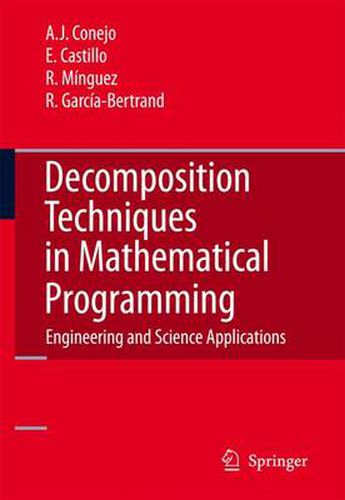Readings Newsletter
Become a Readings Member to make your shopping experience even easier.
Sign in or sign up for free!
You’re not far away from qualifying for FREE standard shipping within Australia
You’ve qualified for FREE standard shipping within Australia
The cart is loading…






This title is printed to order. This book may have been self-published. If so, we cannot guarantee the quality of the content. In the main most books will have gone through the editing process however some may not. We therefore suggest that you be aware of this before ordering this book. If in doubt check either the author or publisher’s details as we are unable to accept any returns unless they are faulty. Please contact us if you have any questions.
Optimization plainly dominates the design, planning, operation, and c- trol of engineering systems. This is a book on optimization that considers particular cases of optimization problems, those with a decomposable str- ture that can be advantageously exploited. Those decomposable optimization problems are ubiquitous in engineering and science applications. The book considers problems with both complicating constraints and complicating va- ables, and analyzes linear and nonlinear problems, with and without in- ger variables. The decomposition techniques analyzed include Dantzig-Wolfe, Benders, Lagrangian relaxation, Augmented Lagrangian decomposition, and others. Heuristic techniques are also considered. Additionally, a comprehensive sensitivity analysis for characterizing the solution of optimization problems is carried out. This material is particularly novel and of high practical interest. This book is built based on many clarifying, illustrative, and compu- tional examples, which facilitate the learning procedure. For the sake of cl- ity, theoretical concepts and computational algorithms are assembled based on these examples. The results are simplicity, clarity, and easy-learning. We feel that this book is needed by the engineering community that has to tackle complex optimization problems, particularly by practitioners and researchersinEngineering,OperationsResearch,andAppliedEconomics.The descriptions of most decomposition techniques are available only in complex and specialized mathematical journals, di?cult to understand by engineers. A book describing a wide range of decomposition techniques, emphasizing problem-solving, and appropriately blending theory and application, was not previously available.
$9.00 standard shipping within Australia
FREE standard shipping within Australia for orders over $100.00
Express & International shipping calculated at checkout
This title is printed to order. This book may have been self-published. If so, we cannot guarantee the quality of the content. In the main most books will have gone through the editing process however some may not. We therefore suggest that you be aware of this before ordering this book. If in doubt check either the author or publisher’s details as we are unable to accept any returns unless they are faulty. Please contact us if you have any questions.
Optimization plainly dominates the design, planning, operation, and c- trol of engineering systems. This is a book on optimization that considers particular cases of optimization problems, those with a decomposable str- ture that can be advantageously exploited. Those decomposable optimization problems are ubiquitous in engineering and science applications. The book considers problems with both complicating constraints and complicating va- ables, and analyzes linear and nonlinear problems, with and without in- ger variables. The decomposition techniques analyzed include Dantzig-Wolfe, Benders, Lagrangian relaxation, Augmented Lagrangian decomposition, and others. Heuristic techniques are also considered. Additionally, a comprehensive sensitivity analysis for characterizing the solution of optimization problems is carried out. This material is particularly novel and of high practical interest. This book is built based on many clarifying, illustrative, and compu- tional examples, which facilitate the learning procedure. For the sake of cl- ity, theoretical concepts and computational algorithms are assembled based on these examples. The results are simplicity, clarity, and easy-learning. We feel that this book is needed by the engineering community that has to tackle complex optimization problems, particularly by practitioners and researchersinEngineering,OperationsResearch,andAppliedEconomics.The descriptions of most decomposition techniques are available only in complex and specialized mathematical journals, di?cult to understand by engineers. A book describing a wide range of decomposition techniques, emphasizing problem-solving, and appropriately blending theory and application, was not previously available.